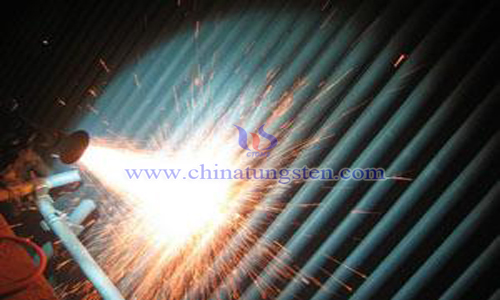Wear Resistant Tungsten Carbide Coatings Prepared by Supersonic Flame Spraying
- Details
- Category: Tungsten Information
- Published on Friday, 19 July 2019 23:46
The front and rear casings of the aero-engine compressor are made of iron-based and nickel-based alloys respectively. During the process of use, the butt joints of the front and rear casings are in a vibrating state, and are prone to impact wear and damage after a period of wear. The life of the front and rear casings is shortened, so it is necessary to prepare a coating with high wear resistance to solve the wear of aviation equipment and prolong the service life of aviation equipment.

In view of the above technical problems, the industry mainly uses tungsten carbide coating materials. Tungsten carbide is a well-known coating material, which can greatly improve the erosion resistance and wear performance of iron-based or nickel-based composite materials. Currently, tungsten coating is prepared. Common methods include chemical vapor deposition, supersonic flame spraying, and plasma spraying.
For aeroengine, some scholars have used supersonic flame spraying method to prepare high density tungsten carbide wear resistant coatings, which are carried out in the following steps:
1.Dry tungsten carbide coated powder flat with a thickness of 10-30 mm, a drying temperature of 90-110 ℃ and a drying time of at least 2 hours.
2.Clean the surface of iron-based or nickel-based forged alloys with organic solvents, and then remove the oxide scales and other impurities by sand blowing. The organic solvent is ethanol or acetone.
3.Fixed iron-based or nickel-based forged alloys and sprayed the above tungsten carbide coating powder onto the surface of iron-based or nickel-based forged alloys by supersonic flame spraying equipment. The spraying parameters are as follows: spraying distance 360-390 mm, powder feeding rate 65-80 g/min, gas pressure 3.5-4.0 bar, and wear-resistant coating is obtained.
4. Clean up the surface of iron-based or nickel-based forged alloys.
The powder compositions of the above tungsten carbide coatings are Co 15-19%, C 4.5-6%, Fe 0-2.5% and W by weight percentage.
The obtained wear-resistant coatings have a thickness of 0.20-0.35 mm. The microstructure of the coatings is characterized by uniform distribution of carbides in the cobalt matrix, less than 10% interface pollution, less than 1% oxide content in the coatings, less than 0.5% porosity and 40-65% unmelted particles. The tensile strength of the coatings is at least 69MPa, the macrohardness of R15N is at least 85, and HV0.3 micro-structure. The hardness ranges from 950 to 1300, and the wear resistance of the coatings obtained by plasma spraying is greatly improved.
The preparation method of high density tungsten carbide wear resistant coatings by supersonic flame spraying is reliable and suitable for mass production. It can not only be used for coating the wear resistant coatings on the front and rear casing joints of aeroengine compressors, but also for various types of ground gas turbines, energy, power and printing industries. Coating of wearable parts can effectively prolong the service life of parts and has a wide application prospect. The results show that the tensile strength of the coatings is at least 69MPa, the macrohardness of R15N is at least 85, and the microhardness of HV0.3 is 950-1300. Compared with the coatings obtained by plasma spraying, the wear resistance of the coatings is greatly improved. The life of front and rear casing of engine compressor is increased from 200h to 1000 h.
- Tungsten Carbide Manufacturer & Supplier, Chinatungsten Online: tungsten-carbide.com.cn
- Tungsten News & Prices of China Tungsten Industry Association: www.ctia.com.cn
- Molybdenum News & Price: news.molybdenum.com.cn
- Tel.: 86 592 5129696; Fax: 86 592 5129797; Email: sales@chinatungsten.com



 sales@chinatungsten.com
sales@chinatungsten.com